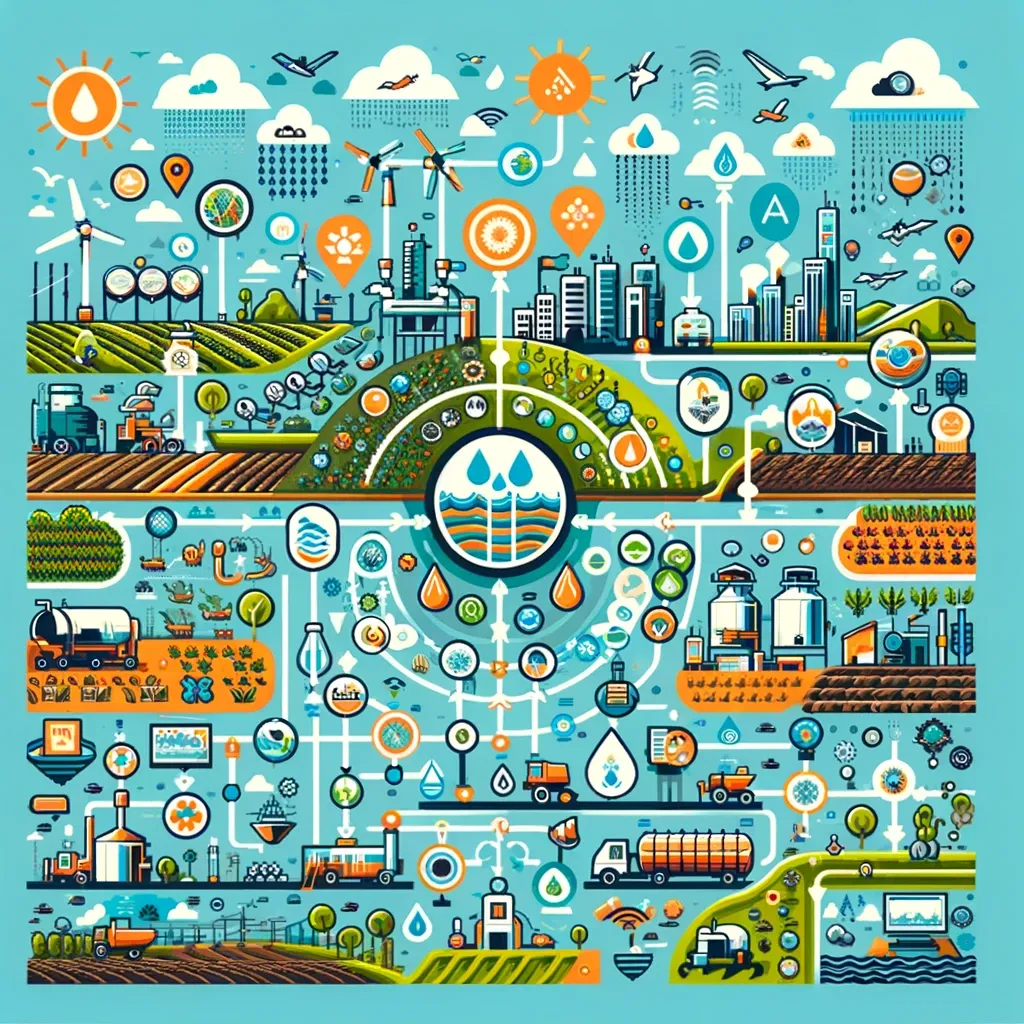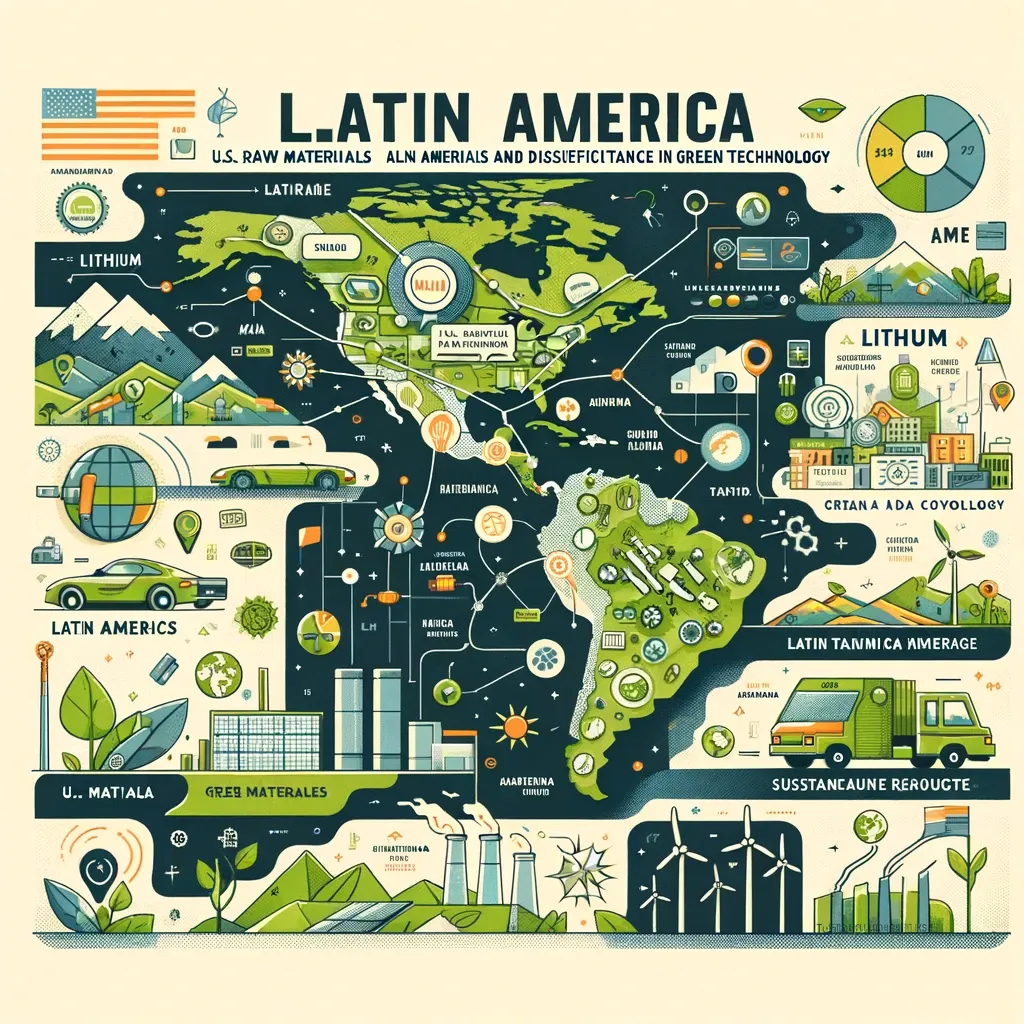Panama and the Green Bridges of Trade: Strengthening U.S.-LATAM Partnerships through Sustainable Innovation
Discover how Panama is transforming into a green energy hub, fostering U.S.-LATAM partnerships, boosting job creation, and curbing illegal immigration. A new era of economic development and sustainable trade is underway

Panama's strategic location, emphasizing its role in green energy with the inclusion of wind turbines and solar panels. It visually represents Panama's emerging status as a green energy hub in U.S.-LATAM trade.
Panama, a nation historically recognized for its vital canal, is now emerging as a pivotal player in the realm of green energy and sustainable development. This strategic shift is not just an environmental statement; it's a robust economic and geopolitical strategy that promises substantial benefits for both Latin America and the United States.
The Strategic Importance of Panama
Panama's geographical position as a bridge between North and South America is unparalleled. The Panama Canal, an engineering marvel, has long been a linchpin in global trade. Today, Panama is leveraging this strategic asset to become a global leader in green energy.
Green Energy Initiatives in Panama
Recent investments in renewable energy infrastructure, including solar and wind farms, are transforming Panama into a green energy powerhouse. These initiatives are not only reducing the country's carbon footprint but also positioning it as a hub for sustainable trade.
U.S.-LATAM Trade Relations: A Sustainable Economic Renaissance
The symbiotic relationship between the United States and Latin America and the Caribbean (LATAM) regions transcends mere trade; it's a testament to the power of cross-border collaborations in ushering an economic renaissance through renewable energy initiatives. This partnership, exemplified by the U.S.-Panama collaboration, serves as a beacon for the global shift towards sustainability, highlighting the critical role LATAM countries play in the worldwide transition to greener economies.
Cross-Border Collaborations: The Keystone of Sustainable Progress
The fabric of U.S.-LATAM trade relations is interwoven with green technology and innovation, showcasing a portfolio of cross-border collaborations in renewable energy projects. These partnerships not only bolster economic growth but also foster the development of sustainable solutions critical for the environmental well-being of our planet. The U.S. and LATAM countries are setting a global precedent, demonstrating how international cooperation can lead to significant advancements in green technology.
Economic Renaissance in Renewable Energy
The economic renaissance in renewable energy within LATAM, supported by U.S. partnerships, signifies a shift from traditional to sustainable economic models. This transition is not just about environmental stewardship but also about creating robust, resilient economies capable of withstanding global challenges. The emphasis on renewable energy projects catalyzes job creation, technological innovation, and ultimately, a stronger, more sustainable economic framework for future generations.
The Global Shift Towards Sustainability
Amidst the global shift towards sustainability, LATAM's role is increasingly pivotal. By embracing green technology and innovation, LATAM countries are contributing significantly to the worldwide endeavor to mitigate climate change. This aligns with the broader themes discussed in the PILLAR content, emphasizing the urgency and the collaborative effort required to propel the global community towards a more sustainable future.
Green Technology and Innovation: The Path Forward
The commitment to green technology and innovation is at the core of U.S.-LATAM trade relations. This partnership leverages cutting-edge solutions in the renewable energy sector, driving progress not just within the respective countries but also setting a benchmark for global sustainability efforts. The integration of innovative practices in renewable energy exemplifies the transformative potential of U.S.-LATAM collaborations, underscoring the importance of continued investment and cooperation in green technologies.
Economic and Employment Benefits
This partnership is poised to create a plethora of job opportunities in both regions. The green energy sector is labor-intensive, meaning that increased investment translates directly into more jobs. For the U.S., this means job creation at home and abroad, reducing the push factors of illegal immigration by providing sustainable livelihoods in Latin America.
Job Creation Through Green Tech
An example of this is the wind energy sector in Panama. U.S. companies have played a significant role in developing wind farms across the country, creating thousands of jobs and boosting local economies.
Case Study: The Sarigua Solar Park - A Beacon of Renewable Progress
The Sarigua Solar Park stands as a testament to Panama's commitment to renewable energy and sustainable development. This large-scale solar project, one of the most significant in Central America, represents a pivotal step in Panama's journey towards a green energy future.
Impact on Renewable Energy Generation
- Capacity and Output: Sarigua Solar Park boasts a substantial capacity, capable of generating a significant amount of Panama's electricity needs. Its output is equivalent to powering thousands of homes, thereby reducing reliance on fossil fuels.
- Technological Advancements: Utilizing cutting-edge solar technology, the park optimizes energy conversion efficiency. This aspect underscores Panama's role in adopting innovative solutions in renewable energy.
Economic Growth and Job Creation
- Employment Opportunities: The construction and operation of the Sarigua Solar Park have created numerous jobs. These range from technical positions in engineering and maintenance to administrative roles, contributing to local employment growth.
- Stimulating Local Economies: The park has had a ripple effect on the local economy. The demand for services, supplies, and infrastructure related to the project has benefited local businesses and entrepreneurs.
Environmental Benefits
- Carbon Footprint Reduction: By generating clean energy, the Sarigua Solar Park significantly cuts down carbon emissions, contributing to Panama's goals in combating climate change.
- Sustainable Energy Model: The project serves as a model for sustainable energy development, showcasing how large-scale solar power can be harmoniously integrated into the environment without adverse ecological impacts.
Broader Implications for U.S.-LATAM Trade
- Attracting International Investment: The success of the Sarigua Solar Park has attracted attention from international investors, including those from the U.S., looking to capitalize on green energy opportunities.
- Strengthening U.S.-LATAM Partnerships: The park exemplifies how U.S. technology and investment can play a crucial role in LATAM's renewable energy sector, fostering stronger economic ties.
A Model for the Future
The Sarigua Solar Park is more than just a power generation facility; it is a symbol of Panama's potential to lead the way in renewable energy in Latin America. Its success demonstrates how green initiatives can be drivers of economic growth, job creation, and environmental stewardship.
As Panama continues to expand its renewable energy portfolio, it sets a precedent for other countries in the region, underlining the viability of sustainable energy as a cornerstone for economic development and international collaboration.
Case Study: Energizing Employment - The Wind Energy Sector in Panama
The Emergence of Wind Energy in Panama
The wind energy sector in Panama has witnessed significant growth in recent years, driven by both domestic and international efforts to harness renewable energy sources. This growth is epitomized by the development of various wind farms across the nation, often in collaboration with U.S. companies.
Role of U.S. Companies
- Investment and Technology Transfer: U.S. companies have been instrumental in bringing both financial investment and cutting-edge wind technology to Panama. Their involvement has accelerated the development of the sector.
- Collaboration and Training: These companies have also collaborated with local firms and institutions, providing training and knowledge transfer, essential for the sustainable growth of the sector.
Job Creation and Economic Impact
- Direct Employment Opportunities: The construction and operation of wind farms have generated thousands of jobs in Panama. These range from on-site construction roles to technical positions like turbine maintenance and operations.
- Indirect Economic Boost: Beyond direct employment, the wind energy sector has stimulated growth in ancillary industries such as transportation, logistics, manufacturing of components, and service sectors, further expanding job opportunities.
Environmental and Social Benefits
- Reducing Carbon Emissions: Wind farms significantly contribute to reducing greenhouse gas emissions, aligning with Panama's commitments to environmental sustainability.
- Community Development: Many wind energy projects involve local communities, offering not just jobs but also opportunities for community development and participation in sustainable initiatives.
Case Example: The Penonomé Wind Project
The Penonomé Wind Project serves as a prime example of the sector's success. It is one of the largest wind farms in Central America and a flagship project in Panama's renewable energy portfolio.
- Capacity and Output: The project, with its impressive capacity, is capable of supplying a substantial portion of Panama's electricity needs, marking a shift towards cleaner energy sources.
- Local and International Collaboration: The project illustrates successful collaboration between Panamanian authorities, local communities, and international companies, setting a standard for future renewable energy projects.
Future Prospects and Challenges
- Scaling Up: The challenge ahead is to scale these initiatives, integrating more wind energy into Panama's national grid.
- Sustainability and Inclusivity: Ensuring that the growth of the wind energy sector remains sustainable and inclusive, benefiting a wide range of stakeholders, will be crucial.
A Wind of Change
Panama's wind energy sector exemplifies how green technology can be a powerful catalyst for job creation and economic growth. The involvement of U.S. companies has not only accelerated the development of this sector but has also created a model of international collaboration that can be replicated in other parts of Latin America.
As Panama continues to harness the power of the wind, it sets a path towards a more sustainable and prosperous future, resonating with global efforts to combat climate change and drive economic development.

A diverse group of workers in Panama, engaged in a solar panel installation project. This scene underscores the theme of job creation and economic growth.
Conclusion: Panama's Role in Regional Stability
Panama's transition to a green energy hub is more than an environmental or economic initiative; it's a strategic move towards regional stability. By fostering economic growth and creating jobs through sustainable trade, Panama is addressing one of the root causes of illegal immigration: lack of economic opportunities.
The success of Panama in this green revolution is a beacon of hope for sustainable development and a testament to the power of strategic U.S.-LATAM joint ventures and partnerships.
=====
Did you know?
Did you know that U.S. Small and Medium Enterprises (SMEs) can capitalize on Panama's strategic position as the green gateway to Latin America using AI-driven marketing strategies? As Panama leads in eco-friendly trade and economic growth, it provides a unique platform for American businesses to explore innovative marketing approaches.
One notable opportunity is utilizing AI for market intelligence and trend analysis. AI tools can dissect complex trade patterns and consumer behaviors in Panama, allowing U.S. SMEs to identify niches within the green market. This insight enables targeted, impactful marketing campaigns for products and services that align with Panama's sustainable trade initiatives.
Moreover, AI can aid in developing cross-cultural marketing strategies. Given Panama's unique position as a bridge between North and South America, AI-driven algorithms can help tailor content to resonate with both local Panamanian audiences and broader Latin American markets, enhancing engagement and fostering stronger business relationships.
AI-driven content personalization is another key area. By analyzing data on consumer preferences and sustainability trends, AI can assist U.S. SMEs in creating content that speaks directly to the growing eco-conscious audience in Panama. This could include highlighting how American products or services contribute to sustainable trade and economic growth.
In addition, AI can optimize digital marketing campaigns, ensuring that U.S. SMEs' promotional efforts are seen by the most relevant sectors in Panama. By using AI for targeted advertising, businesses can efficiently reach potential partners and customers who are actively involved or interested in green initiatives and sustainable trade.
Furthermore, AI tools can provide predictive insights, helping U.S. SMEs anticipate future trends in Panama's green trade sector. This foresight is invaluable for staying ahead of the curve and aligning marketing strategies with emerging opportunities.
Lastly, AI technology can enhance language and cultural translation of marketing materials, ensuring that they not only communicate effectively in Spanish but also reflect Panama’s unique cultural nuances. This level of localization is crucial for building trust and rapport in a diverse and dynamic market like Panama.
By harnessing these AI Marketing strategies, U.S. SMEs can effectively engage with Panama's evolving green trade landscape, unlocking new avenues for growth and solidifying their presence in the U.S.-LATAM trade corridor.





























